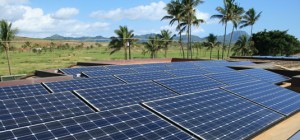Hawaii and Nevada represent two states pioneering a “post-net metering” world for rooftop solar. Collectively, they’re providing some interesting learning experiences for the rest of the country.
Many other states have traditional net metering, in which any surplus rooftop solar energy you produce for the grid is credited at a full retail rate on your bill. But Hawaii and Nevada utilities have successfully pushed back on that approach, convincing state regulators to diminish or even gut the incentives.
 First, Hawaii: the state has significant rooftop solar uptake, with a nation-leading 17% of all customers in the main utility’s service territory. But the utility there has been trying to fight further proliferation with the usual arguments related to reliability and cost.
First, Hawaii: the state has significant rooftop solar uptake, with a nation-leading 17% of all customers in the main utility’s service territory. But the utility there has been trying to fight further proliferation with the usual arguments related to reliability and cost.
The state’s regulator has largely followed the utility line, ending net metering and replacing it with two options. The first is a fixed rate payment for surplus power that is less than the full retail credit, called a “grid supply” option. The second is a “self-supply” option that features a minimum bill and only some surplus power allowed back on the grid.
Perhaps not surprisingly, the fixed rate “grid supply” option has been the most popular. But regulators imposed a cap on that program, which the islands have already started to bump up against. As a result, solar companies are lobbying hard for regulators to raise the cap. But even if they raise the cap, the long-term problem isn’t going away.
So that’s why it’s interesting to see the market in Hawaii respond with technology packages to help spur demand for the self-supply option. As Utility Dive reports:
Other solar developers like Sunrun and SolarCity have rolled out offerings aimed at the CSS [self-supply] option. SolarCity’s product is a combination of storage, solar systems and a Nest thermostat, water heater and controller, allowing consumers to use more of their energy onsite.
The savings are significant, according to Mark Dyson from Rocky Mountain Institute. By using the product, customers could “save 33% on their electricity bill, “which amounts to “nearly 80% of the savings that the old NEM arrangement offered.”
Sunrun’s Brightbox is another option. The company teamed up with Tesla to offer solar-plus-storage system, a much simpler one than SolarCity. While the first Brightbox installation occurred earlier this year, the company plans to roll out this offering in full force before the end of the year.
Both offerings could receive a boost if a group of energy storage bills reappear in the next legislative session, bringing down the cost of storage installation through extending tax credits, offering rebates or both.
So in Hawaii, we may end up seeing a combination of smart new policies and technology and financing packages that can make a post net-metering world viable there for distributed clean technology.
Nevada, meanwhile, is pulling back from the brink a bit. The state’s electricity regulators had previously yanked all solar incentives — not just for new customers but for existing ones that already plopped down thousands of dollars (in some cases) for rooftop PV.
But now a deal seems to have been worked out to soften the harsh retrenchment. Per the Reno Gazette-Journal:
NV Energy reached an agreement with the Public Utilities Commission of Nevada, Bureau of Consumer Protection and SolarCity to grandfather eligible customers under previous rates for residential rooftop solar that featured lower fees and higher reimbursement rates for the energy produced. The rates were hiked in December and also retroactively applied to existing customers.
“NV Energy’s intent with its grandfathering proposal was to offer a solution for customers who installed or had valid applications to install rooftop solar systems … in the most efficient and timely manner,” the company said in a statement. “We appreciate all parties coming together to expedite the process on behalf of our customers.”
The grandfathering agreement will apply to about 32,000 customers, including those who had a pending application on Dec. 31, 2015. Customers who withdrew a valid application or had their application for the RenewableGenerations expire between Dec. 21 and Dec. 31 are eligible to be grandfathered as well. The agreement still must be approved by the PUC, which is expected to vote on it on this week.
It’s a welcome development for those existing customers, who were treated unfairly by the abrupt policy change. But more will be needed to rescue the state’s rooftop solar industry, which has been annihilated by the new policy. Perhaps Nevada may need to consider a policy more like Hawaii’s grid-supply option as a compromise. But in the meantime, a ballot measure backed by the solar industry could reinstate solar incentives, if voters approve.
All in all, both states provide glimpses of a possible future for state rooftop solar incentives. While some experimentation is happening there, at least in Hawaii, it’s clear that they both need to improve their policies to keep rooftop solar — and the environmental benefits that flow from it — alive and well.
One thought on “Rooftop Solar Wars Continue In Hawaii And Nevada”
-
Pingback: Rooftop Solar Wars Update: Nevada Improves, Arizona Falters, & Tesla Batteries May Benefit | Ethan Elkind
Leave a Reply
You must be logged in to post a comment.



